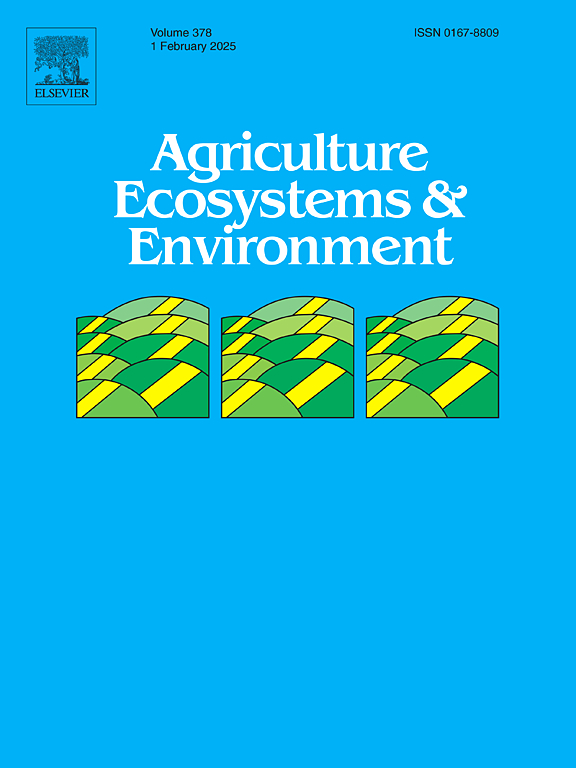Soil organic carbon content and stability of different cropping patterns depends on the distribution and stability of aggregates in the hilly area of central Sichuan basin
IF 6.4
1区 农林科学
Q1 AGRICULTURE, MULTIDISCIPLINARY
引用次数: 0
Abstract
To assess the effects of cropping patterns on soil organic carbon (SOC) content, aggregate distribution, and stability, a 2-year experiment was conducted from 2021 to 2023 based on a long-term trial located in a typical hilly area of central Sichuan basin of China. The experiment was a two-factor split-plot design, with the primary factor being cropping patterns (M), which included three systems: winter fallow paddy-rice (FR), potato-rice (PR), and potato-maize (PM). The secondary factor was straw return mode (S): straw returned to field (RS) and straw not returned to field (NS). The results showed that SOC content was significantly higher in the FR system compared to the PR and PM systems, with no significant difference between the PR and PM systems. The FR system improved the aggregate stability by increasing the content of large aggregates (>0.25 mm) (42.53 %-75.28 %), but it also exhibited the highest content of unprotected organic carbon. In contrast, the PR and PM systems had higher SOC stability than the FR system, with the PR system showing the highest content of microaggregate (16.90 %-45.85 %) and microaggregate-associated organic carbon, which led to a higher proportion of physically protected organic carbon. The PM system was dominated by small aggregates and had the highest content of physico-chemically and physico-biochemically protected organic carbon in a closed-accumulation state. The results of the PLS-PM analysis suggested that soil aggregate characteristics influence SOC sequestration through both direct and indirect effects. In summary, the particle size distribution of aggregates varied across different cropping systems, affecting the stabilization and protection mechanisms of the aggregates, which in turn influenced the SOC content and stability. The FR system had higher SOC content but lower stability, whereas the PR and PM systems had lower SOC content but higher stability.
川中丘陵区不同种植方式土壤有机碳含量和稳定性取决于团聚体的分布和稳定性
为评估不同种植方式对土壤有机碳含量、团聚体分布及稳定性的影响,在川中典型丘陵区的长期试验基础上,于2021 - 2023年进行了为期2年的试验。试验采用双因素分畦设计,以种植模式(M)为主要因素,包括冬休稻(FR)、马铃薯稻(PR)和马铃薯玉米(PM) 3种制度。其次是秸秆还田方式(S):秸秆还田(RS)和秸秆不还田(NS)。结果表明,有机碳含量在FR体系中显著高于PR和PM体系,PR和PM体系之间无显著差异。FR体系通过增加大团聚体(>0.25 mm)的含量(42.53 %-75.28 %)改善了团聚体的稳定性,但其无保护有机碳含量也最高。相比之下,PR和PM体系比FR体系具有更高的SOC稳定性,其中PR体系的微团聚体(16.90 %-45.85 %)和微团聚体相关有机碳含量最高,导致物理保护有机碳的比例更高。PM系统以小团聚体为主,处于封闭积累状态的物理化学和物理生化保护有机碳含量最高。PLS-PM分析结果表明,土壤团聚体特征通过直接效应和间接效应影响土壤有机碳的固存。综上所述,不同种植制度下团聚体的粒径分布不同,影响团聚体的稳定和保护机制,进而影响有机碳含量和稳定性。FR体系有机碳含量较高但稳定性较差,PR和PM体系有机碳含量较低但稳定性较高。
本文章由计算机程序翻译,如有差异,请以英文原文为准。
求助全文
约1分钟内获得全文
求助全文
来源期刊

Agriculture, Ecosystems & Environment
环境科学-环境科学
CiteScore
11.70
自引率
9.10%
发文量
392
审稿时长
26 days
期刊介绍:
Agriculture, Ecosystems and Environment publishes scientific articles dealing with the interface between agroecosystems and the natural environment, specifically how agriculture influences the environment and how changes in that environment impact agroecosystems. Preference is given to papers from experimental and observational research at the field, system or landscape level, from studies that enhance our understanding of processes using data-based biophysical modelling, and papers that bridge scientific disciplines and integrate knowledge. All papers should be placed in an international or wide comparative context.
 求助内容:
求助内容: 应助结果提醒方式:
应助结果提醒方式:


